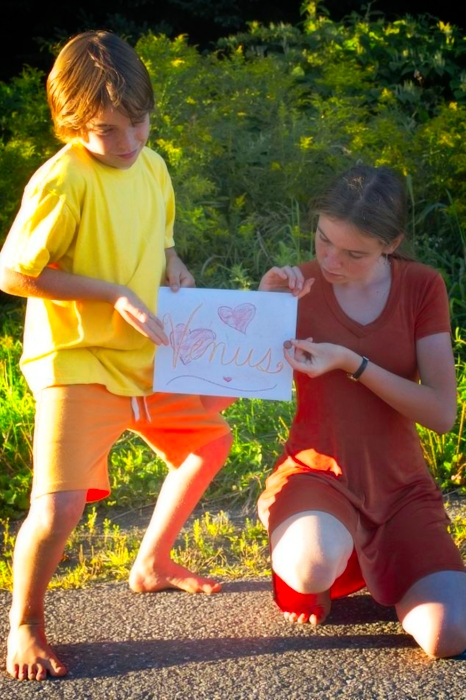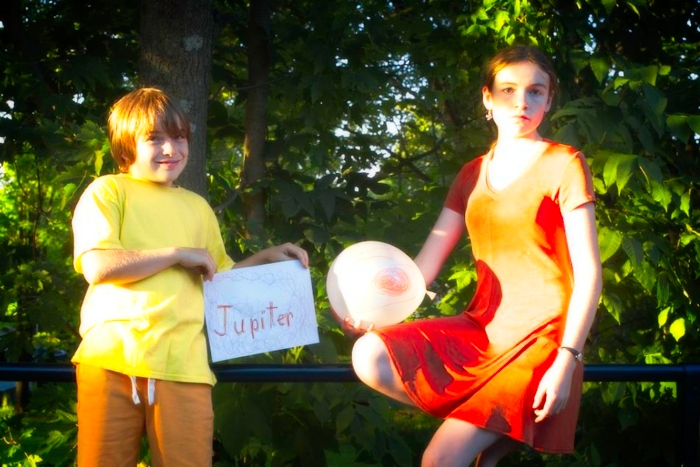We’re doing a science program called Science is WEIRD, which I absolutely LOVE.
The only thing I think its lacking is a bit more of a hands-on component, so I add one. For the first unit, Universe, we built a scale-model solar system from the sun to Neptune. As you can see on the map (below), we didn’t exactly make a straight line. Although it’s true that the planets generally don’t march around the sun in a straight line, for the sake of clarity, a solar system model is usually represented as if the planets are swinging around the sun in a systemic game of snap-the-whip.

Windslow Homer, Snap the Whip, 1872
Here’s where it makes a difference. Scientists measure the distances between planetary orbits, which are relatively stable, as opposed to the distances between planets themselves, which change from day to day. In our model, the distances between planets actually represent the distances between planetary orbits. Because I measured the distance from planet to planet instead of the average distance from each planet to the sun, the planets in our model system are technically out of orbit. Oops! I suppose we could have started on the bridge over the Coaticook river and headed south on rue Principal in order to get a more direct line from the sun to Neptune, but, eh, I didn’t think of that. I just decided, very un-scientifically, to start at Shirley’s house and go from there.
On this map, the dot in the upper left represents the sun.
The planets follow along the road in order: Mercury, Venus, Earth, Mars, Jupiter, Saturn, Uranus, Neptune.

SUN
The sun, located at the corner of rue King & chemin Gale, is about the size of a compact car.
I had intended to ask Shirley if her little red car could pose for our sun,
but she wasn’t home, so I had the kids dress up brightly and stretch out about sun-width across.
In our model, the diameter of the sun is a bit over 2 meters.

MERCURY
The rock planets are modelled from play dough.
Mercury, the smallest planet, measures 0.75 cm across.

Its orbit is located 91 meters from the sun, in front of Cassandre’s house.
Mercury is visible between the thumb and forefinger of Iris’s right hand, near the base of the big “M.”

VENUS
Venus, the second rock from the sun and the second-largest of the four rock planets,
spins contrary to the rotation of the sun, as does the planet of her mythical father, Uranus,
from whose genitals she sprung when Cronus castrated him and flung the bloody gore across the sky
into the foamy sea.
Closest in size to Earth, Venus is 1.9 cm in diameter.

Venus is visible between the thumb and forefinger of Iris’s left hand, slightly above the letter “s.”
It is located 79 meters from Mercury, with an orbital distance of 170 meters.

EARTH
Earth, the largest of the four rock planets and everybody’s favourite,* measures 2.0 cm across.
*if Earth is not your favourite planet, it is a sign that you may be an alien.

Situated in front of the neighbour’s house due west of us,
Earth can be seen at the lower end of the trajectory between the two index fingers of Iris’s hands.
It is located 65 meters from Venus, with an orbital distance of 236 meters.

MARS
Mars, surprisingly small despite its outsized fame, is only 1.06 cm in diameter, nearly half the width of Earth.
In volume, one would need to smush up about 6.5 model Mars planets to be able to form just a single model Earth.
That’s not how Earth was actually formed, partly because Mars is not actually mushy,
and partly for other very scientific reasons.

Mars is visible between the thumb and forefinger of Akiva’s right hand, to the left of the great “M.”
The ultimate rock planet, it is located 123 meters past Earth, with an orbital distance of 358 meters.

JUPITER
The gaseous-mixture, or air planets, are represented by balloons.
These planets are made of star-stuff and rain diamonds.
Jupiter is the largest planet in our solar system, with a diameter of 22.4 cm.
We would have needed to mush up 13,000 little Earths to form them into a Jupiter.
This is unrealistic: I have neither enough time nor enough flour, and Jupiter is not solid.

Jupiter is located 865 meters past Mars, beyond the asteroid belt (not represented).
It has an orbital distance of 1,223 meters and can be found by the Maison Jeune.

SATURN
Saturn, the second-largest planet, measures 18.9 cm in diameter.
Like its son, Jupiter, Saturn rains diamonds, has a permanent storm, and is skirted by rings.
But, as if to make up for its slightly smaller size, Saturn’s storm is hexagonal,
and its rings are the most famous of them all.

With an orbital distance of 2,241 meters, Saturn is 1,018 meters past Jupiter
near a farm now known as “Saturn Farm.”

URANUS
Overthrown by his mythical son Saturn, in turn overthrown by Jupiter,
Uranus has a diameter of a 8.0 cm and a rotation perpendicular to its orbit.

On its trajectory 4,510 meters from the sun, Uranus is located 2,269 meters beyond Jupiter
near a farm now known as “Uranus Farm.”

NEPTUNE
The smallest of the air planets and furthest planet from the sun, Neptune is only 7.8 cm in diameter.

A cold planet, far from the sun, Neptune is notoriously dim and difficult to photograph.
2,556 meters from Uranus, Neptune has an orbital distance of 7,066 meters.

Driving the seven kilometers back home, I asked: What is there most of in space?
and the kids answered: Space!




I want to go to your school!
It’s an all-ages school! Come join us!